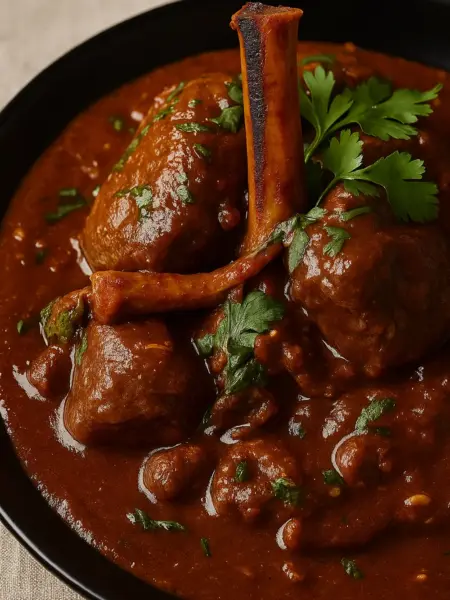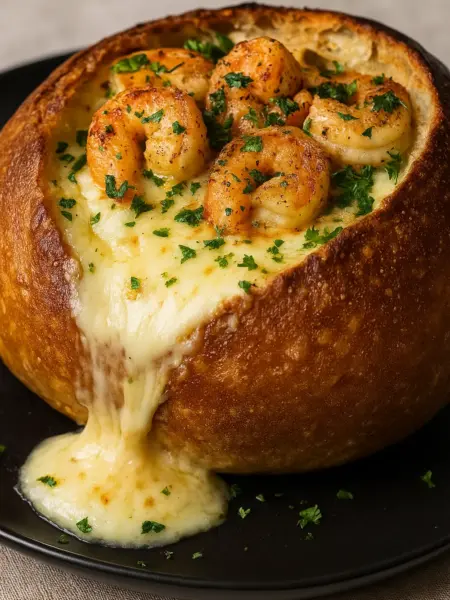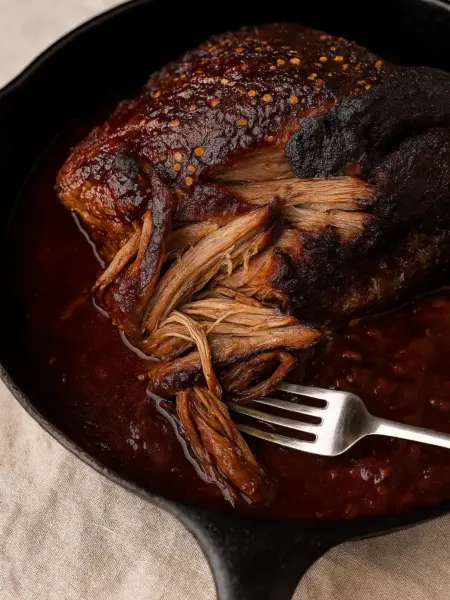This post may contain affiliate links, meaning I may earn a commission if you make a purchase, at no extra cost to you. I only recommend products I trust. Thank you for your support.
Coq au vin is a classic French dish that literally means “rooster in wine,” featuring chicken slowly cooked in red wine with mushrooms, onions, lardons or bacon, garlic, and aromatic herbs for a rich, comforting flavor.
Its origins trace back to French farmers who found a clever way to make use of an older, tougher rooster by slowly braising it in wine until it became wonderfully tender and deeply flavorful.
This traditional coq au vin recipe features tender chicken slowly braised in dry red wine with lardons, earthy mushrooms, onions, and fragrant herbs, creating a rich, glossy sauce that’s pure comfort in every bite.
In this recipe, we use a dry, young red wine like Pinot Noir and finish with a touch of beurre manié to create a glossy, stable, and luxuriously velvety sauce.
Coq au vin rose to worldwide fame largely thanks to Julia Child, whose iconic recipes and cookbooks brought this quintessential French country classic into the heart of the American kitchen.
This chicken coq au vin recipe is surprisingly easy to make, serves six, and is perfect for a cozy Sunday dinner, a romantic date night, or a festive holiday celebration like Christmas, Thanksgiving, or Easter.
This classic coq au vin recipe is a true cornerstone of French country cooking, often spoken of alongside timeless dishes like Boeuf Bourguignon and the slow-simmered Cassoulet.
✅ Take a moment to read through the whole post for the ingredient list, expert tips, and equipment suggestions. The full recipe is right below.
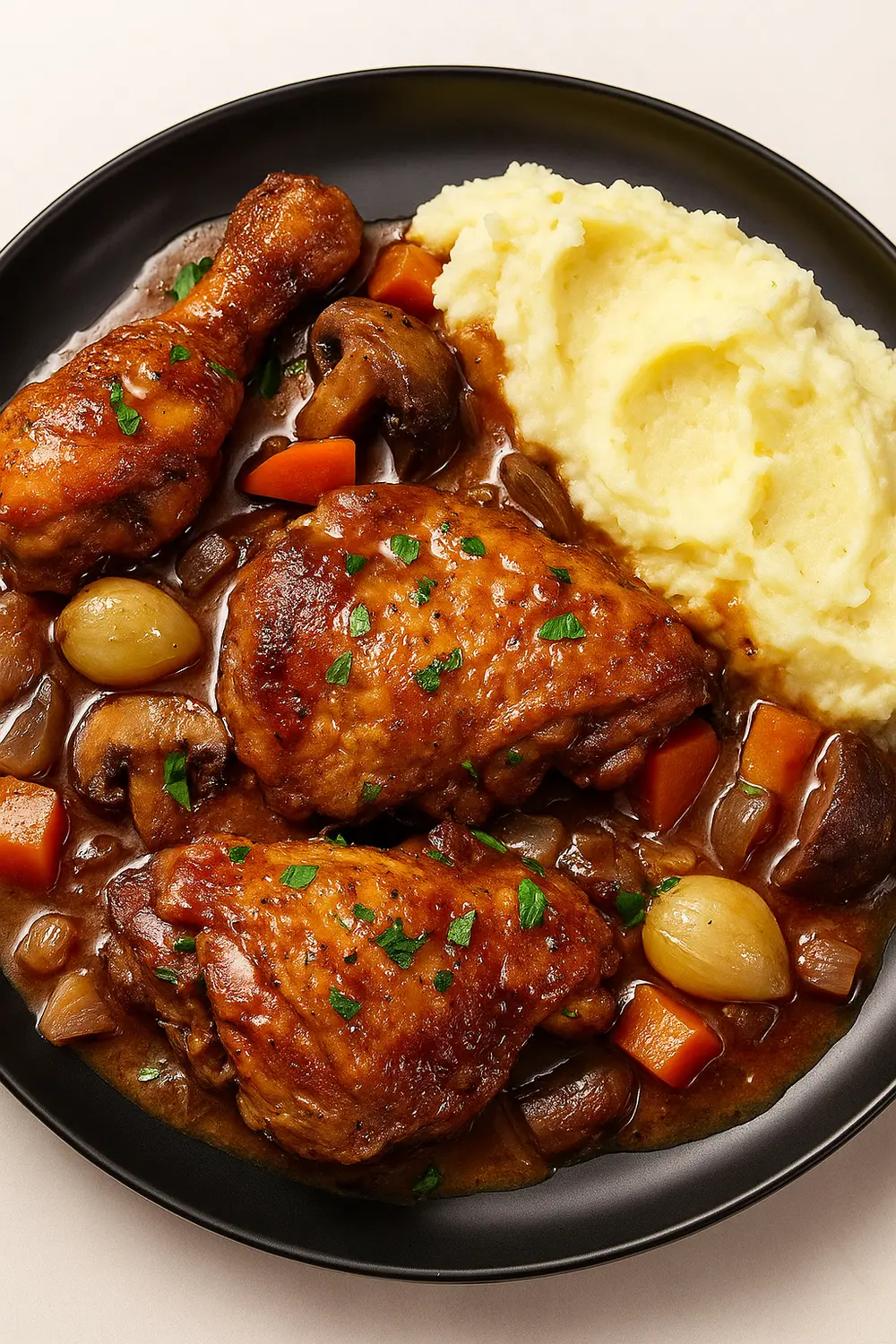
Key Ingredients for This Traditional Coq Au Vin Recipe
The quality of the final dish depends directly on the ingredients chosen, as each one plays a distinct and essential role in shaping the dish’s overall character and flavor.
1. Chicken
- While the dish historically used tough old rooster (coq), modern chicken coq au vin recipes use the bone-in, skin-on thighs and drumsticks for the best flavor and tenderness.
- Dark meat, such as thighs and drumsticks, is preferred for its higher fat content and rich flavor, which allows it to endure long braising without drying out and create a perfect pull-apart tenderness.
2. Lardons
- Lardons are small strips or cubes of thick-cut slab bacon or salt pork, essential not just for their smoky flavor but also for the technique they bring to the dish.
- Rendering the fat from the lardons creates the flavorful base for browning the chicken, infusing the entire dish with a rich, smoky, and subtly salty depth.
3. Dry Red Wine
- A high-quality dry red wine is, arguably, the most important ingredient, transforming the braising liquid into the deep, luscious sauce.
- The red wine must be dry and young, ideally a Pinot Noir, which is the cornerstone of Burgundy and is traditional for this dish.
- Excellent substitutes that offer similar depth and fruit structure include Zinfandel, Beaujolais, or Côtes du Rhône.
4. Fresh Aromatics
- Onions, carrots, garlic, thyme, and bay Leaves form the aromatic core of the braising liquid.
- They soften into the sauce, adding sweetness from the carrots and onions, depth from the garlic, and aromatic herbal notes from thyme and bay leaf.
5. Mushrooms and Pearl Onions
- These are the essential, classic garnishes usually sautéed separately in butter to ensure they develop a beautiful golden-brown color and intense earthy flavor.
- They provide both texture and a sweet counterpoint to the rich red wine sauce.
6. Cognac or Brandy
- Cognac or brandy is often added and briefly ignited to burn off the alcohol, leaving behind a deep, aromatic richness that adds beautiful complexity to the sauce.
- This technique leaves behind only the deep, complex aromas of the liquor, adding a subtle layer of sophistication and depth to the finished sauce.
7. Beurre Manié
- This simple mixture of flour and unsalted, softened butter is the secret to achieving a perfect, restaurant-quality sauce.
- It is whisked in at the very end to thicken the braising liquid into a silky, luscious sauce that coats the chicken without becoming heavy or starchy.
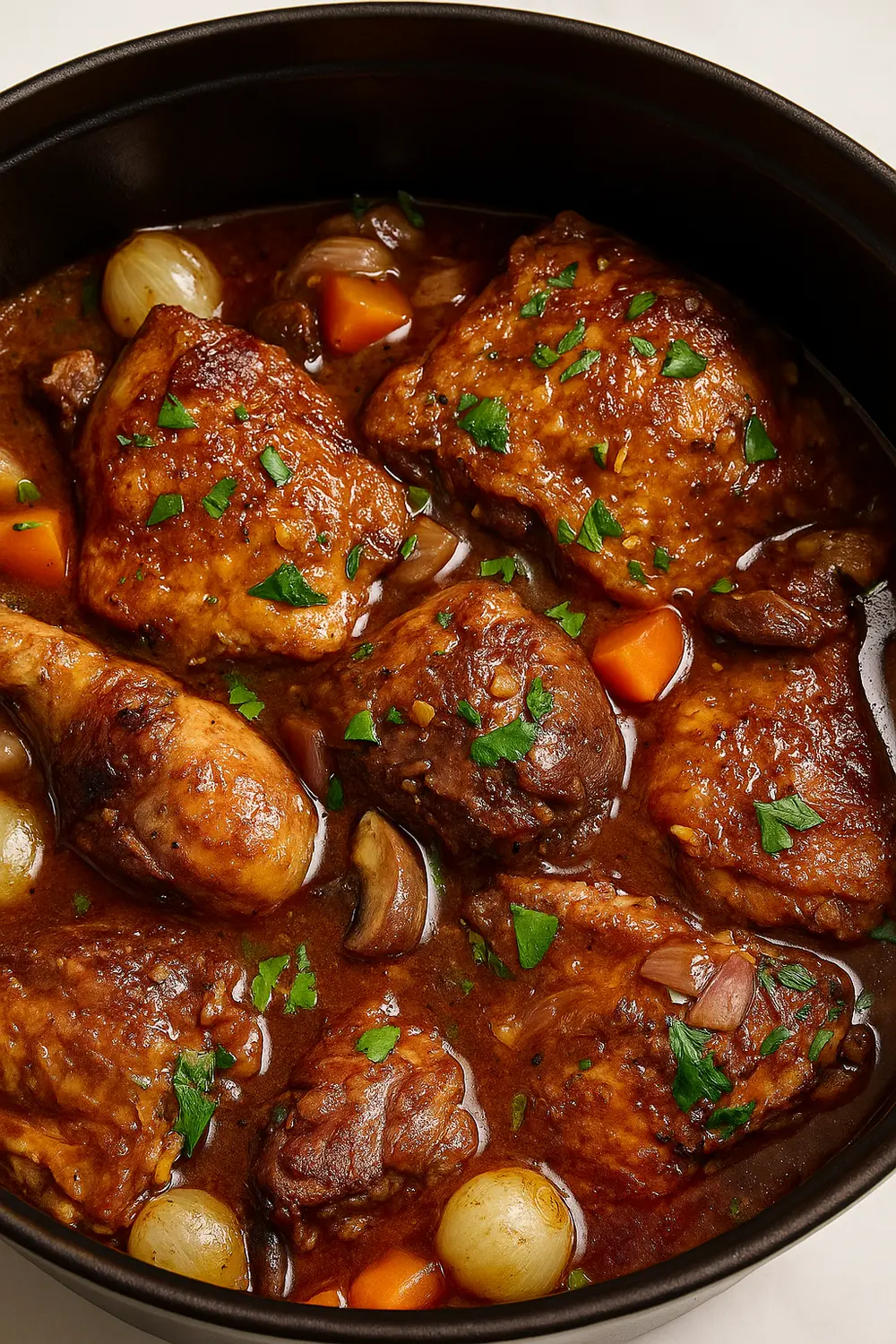
Essential Tools for This Julia Child Coq au Vin Recipe
Successful braising requires the right kitchen tools that can handle both high heat for searing and sustained, even heat for slow cooking.
- Heavy-Bottomed Dutch Oven: A large, heavy pot like cast iron or enameled cast iron ensures even heat, prevents hot spots, and maintains a gentle oven temperature for tender, perfectly braised chicken.
- Long Kitchen Matches or Lighter: This too is needed for safely igniting the Cognac during the flambé step, keeping your hands a safe distance from the flame.
- Large Sauté Pan or Skillet: While the Dutch oven is used for the main braise, a separate skillet is often required to properly sauté and brown the mushrooms and pearl onions.
- Fine-Mesh Sieve or Strainer: Used to strain the braising liquid if you opt to skim the fat immediately, or to easily remove the bay leaf and thyme sprigs before thickening the sauce.
- Slotted Spoon and Tongs: Essential for removing the crispy lardons and the seared chicken pieces from the pot.
- Small Mixing Bowl and Fork: Needed for mashing the softened butter and flour together to create the beurre manié, the quick, clump-free sauce thickener.
Why You’ll Love This Chicken Coq au Vin
Here are the key reasons this easy coq au vin recipe earns its place as a weekend meal:
- Deeply Layered and Complex Flavor: The recipe uses classic French techniques, such as searing, deglazing with wine, and slow braising, to create a savory, earthy, and perfectly balanced dish that far outshines a simple stew.
- Make-Ahead Meal: Coq au vin tastes even better the next day, as resting overnight lets the chicken absorb the wine and herbs and allows the sauce to develop richer, more harmonious flavors.
- Exceptional Source of Protein: Dark meat chicken makes this dish incredibly rich in protein (often providing over 50% of the total calories), which is essential for muscle health, satiety, and energy.
- Rich in Essential Minerals: This coq au vin recette provides key minerals like iron, zinc, phosphorus, and selenium, supporting blood health, immunity, and strong bones.
- High in Vitamins: Coq au vin offers significant amounts of Vitamin A from carrots and chicken fat, along with B vitamins (B2, B3, B5, B12) that support metabolism and nerve health.
- Source of Dietary Fiber: The inclusion of root vegetables (carrots, onions) and a generous portion of mushrooms contributes a healthy amount of dietary fiber, supporting digestive health.
- Natural Ingredients, Low in Sugar: This chicken coq au vin recipe uses whole, unprocessed ingredients, with naturally low sugar coming only from the vegetables and red wine.
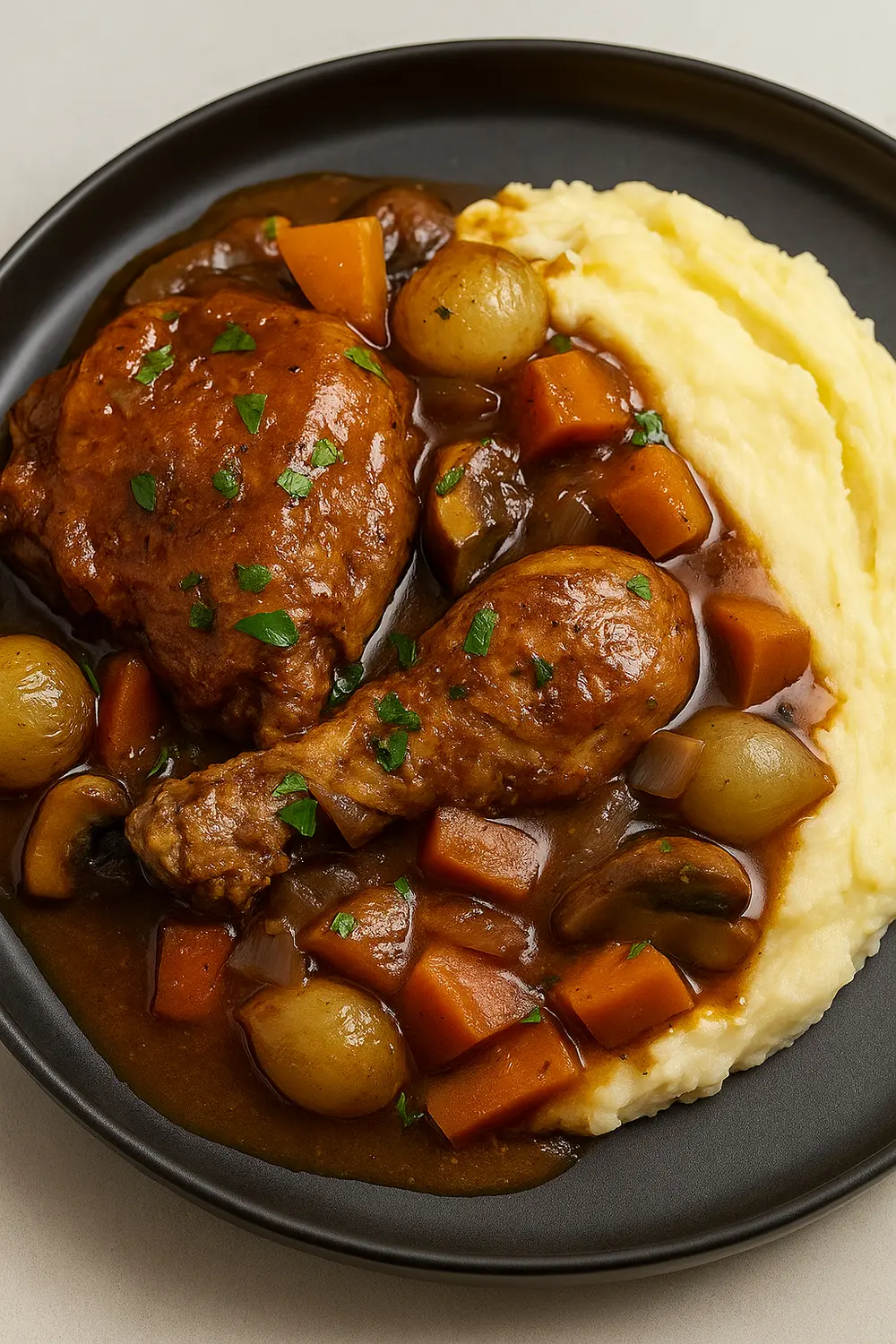
What to Serve with Coq au Vin
The intensely flavored, rich red wine chicken requires side dishes that are both neutral and absorbent to beautifully complement the luxurious sauce.
- Creamy Mashed Potatoes (Pommes de Terre Purée): Buttery, smooth mashed potatoes are perfect for soaking up the velvety chicken in red wine sauce while providing a soft texture contrast.
- Buttered Egg Noodles (Nouilles): Wide, flat egg noodles tossed in butter offer a simple, comforting base that cradles the sauce and mushrooms beautifully.
- Crusty French Baguette: A crusty baguette is essential for a true French experience, perfect for wiping up every last bit of the rich sauce.
- Blanched Green Vegetables: Bright, lightly cooked greens like green beans, asparagus, or broccoli with a touch of lemon provide a fresh, crunchy counterpoint to the rich sauce.
- Simple Green Salad: A light salad dressed with a sharp, simple vinaigrette (red wine vinegar, mustard, and olive oil) provides acidity that helps cleanse the palate between rich, savory bites of the stew.
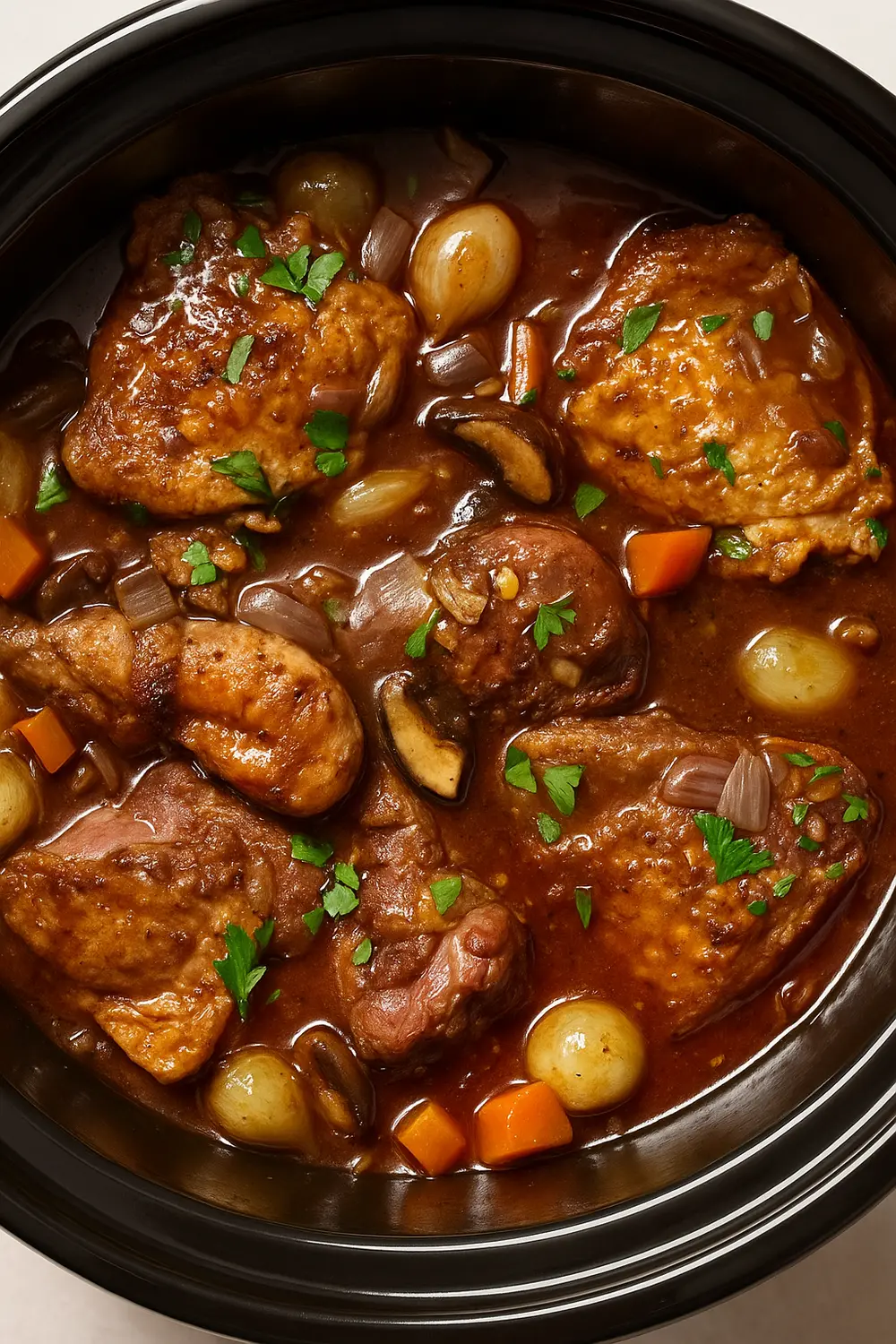
Pro Tips for Making the Best Coq au Vin
Achieving the best coq au vin comes down to mastering a few key professional techniques:
1. Make-Ahead
The key to a perfect sauce is to make the stew 1 to 2 days ahead, then chill it overnight in the refrigerator to let the flavors meld.
The excess fat will solidify on the surface, making it incredibly easy to scrape off and discard before reheating, resulting in a cleaner, richer, and perfectly glossy sauce that is free of unsightly oil slicks.
2. Use Beurre Manié
For a smooth, silky sauce, skip cornstarch or pre-cooked roux and instead use beurre manié (a paste of equal parts softened butter and flour).
Whisk this paste into the simmering sauce at the very end, one tablespoon at a time, waiting two minutes between additions.
This traditional technique allows for precise control, ensuring the sauce is luscious and velvety, never gummy or lumpy.
3. Control the Seasoning
Since ingredients like lardons and chicken stock are often high in sodium, only lightly season the chicken at the start.
Wait to adjust the salt content until the very end, after the sauce has fully reduced and thickened.
4. Flambé the Cognac or Brandy
If using Cognac or brandy, perform the flambé with an 80-proof liquor, warming it slightly and removing the pot from direct heat before igniting with a long match or lighter.
This technique concentrates the liquor’s sophisticated, aromatic flavor while eliminating the raw alcohol taste.
Final Remarks
This classic chicken coq au vin recipe is easy to make and delivers tender, flavorful chicken braised in rich red wine with mushrooms, lardons, and aromatic herbs, creating a luxurious dish that’s perfect for a family dinner or special occasion.
Feel free to swap the chicken for dark meat only if preferred, add extra mushrooms or pearl onions, or finish with a touch of fresh parsley for a pop of color and brightness.
Pair it with creamy mashed potatoes, buttered egg noodles, or a crusty French baguette to soak up every drop of the luscious sauce, and serve alongside blanched green vegetables or a simple green salad.
If you try this recipe, we’d love to hear how it turned out. Share your experience or any twists you made in the comments below.
You’ll find the complete list of ingredients and step-by-step instructions just below.
Traditional Coq au Vin Recipe
This easy coq au vin recipe features chicken slowly braised in a high-quality dry red wine with lardons, mushrooms, onions, and herbs, all simmered together into a rich, glossy sauce.
Ingredients
For the Chicken
For the Braising Liquid
For the Garnish
For the Beurre Manié (Sauce Thickener)
How to Cook Coq Au Vin (Step-By-Step Instructions)
Season the Chicken
- Use paper towels to pat the chicken pieces aggressively dry.
- Season the dried chicken generously with salt and pepper.
Render the Lardons
- In the Dutch oven, add the lardons (or bacon) and render the fat over medium heat until crispy and golden, about 8 to 10 minutes.
- Use a slotted spoon to remove the lardons and reserve them in a side dish, leaving the rendered fat in the pot.
Sear the Chicken
- Increase the heat to medium-high.
- If needed, add 2 tablespoons of olive oil to the rendered fat.
- Sear the chicken skin-side down until a deep mahogany-brown crust forms, about 5 to 7 minutes per side.
- Avoid overcrowding the pot and ensure the chicken pieces don’t touch.
- Remove the chicken pieces from the pot and set them aside.
Sauté Aromatics
- Reduce the heat to medium.
- Add the diced carrots and yellow onions to the remaining fat.
- Sauté until the carrots are softened and onions are lightly browned, scraping up the flavorful brown bits from the bottom of the Dutch oven.
- Add the crushed garlic and tomato paste.
- Cook for one minute until the tomato paste darkens slightly and smells fragrant.
Flambé the Cognac
- Temporarily remove the pot from the heat source.
- Pour in ¼ cup of Cognac or Brandy.
- Return the pot to the heat.
- Ignite the alcohol vapors using a long match or specialized lighter, holding it away from your face.
- Stand back and allow the flames to subside naturally as the alcohol burns off completely.
- This step enhances the dish with deep, complex flavors while removing the raw taste of alcohol.
Deglaze with Red Wine
- Immediately pour in the 2 cups of red wine to fully deglaze the pot.
- Stir vigorously to loosen all the remaining fond from the bottom.
- Bring the wine to a boil and let it reduce by about 25% for roughly 5 minutes to concentrate and deepen the wine’s flavor.
Simmer the Stew
- Return the seared chicken pieces and the reserved lardons to the pot.
- Add the bay leaves and fresh thyme.
- Pour in the chicken stock.
- The liquid should almost cover the chicken pieces entirely.
- Bring the liquid back to a gentle simmer on the stovetop.
- Cover the Dutch oven and transfer it to a preheated 325°F (160°C) oven.
- Let it braise for 1 hour 45 minutes to 2 hours, or until the chicken is fork-tender.
Sauté the Mushrooms and Pearl Onions
- While the stew simmers, melt 2 tablespoons of butter with a teaspoon of olive oil in a separate skillet over high heat.
- Add the mushrooms and sauté vigorously, tossing often, until they release their moisture and turn a deep, golden-brown color, about 8 to 10 minutes.
- Add the pearl onions to the skillet with the mushrooms and cook for an additional 3 to 4 minutes until they are lightly browned and slightly caramelized.
- Season with salt and pepper.
Make the Beurre Manié
- In a small bowl, combine the softened butter and flour, mashing them together thoroughly until a smooth, uniform paste forms.
- This smooth paste is called beurre manié.
Finish the Sauce
- Carefully remove the chicken pieces from the pot and place them on a warm platter.
- Discard the bay leaves and thyme sprigs.
- Bring the braising liquid to a low boil.
- Whisk in the beurre manié, adding one tablespoon at a time.
- Wait 1 to 2 minutes between each addition to let the paste dissolve and the sauce reach the ideal consistency.
- It should be silky and just thick enough to lightly coat the back of a spoon.
- Avoid adding too much, as the goal is a smooth sauce, not a heavy gravy.
- Taste the finished sauce and adjust seasoning with salt and pepper as needed.
- If the sauce remains too thin, simmer it uncovered for another 10 minutes to reduce naturally.
Combine and Simmer
- Gently return the chicken pieces to the Dutch oven.
- Add the sautéed mushrooms and pearl onions to the pot.
- Simmer briefly for 3 to 5 minutes until everything is thoroughly heated.
Serve and Enjoy
- Spoon the coq au vin into bowls or onto plates.
- Garnish generously with fresh chopped parsley.
- Serve with mashed potatoes, crusty baguette, or buttered egg noodles.
Nutrition Facts
Servings 6
Serving Size Approximately 1½ cups
- Amount Per Serving
- Calories 420kcal
- % Daily Value *
- Total Fat 16g25%
- Saturated Fat 5.5g28%
- Cholesterol 125mg42%
- Sodium 580mg25%
- Potassium 650mg19%
- Total Carbohydrate 18g6%
- Dietary Fiber 3g12%
- Sugars 5g
- Protein 58g116%
- Vitamin A 4300 IU
- Calcium 55 mg
- Iron 4 mg
- Vitamin K 55 mcg
* Percent Daily Values are based on a 2,000 calorie diet. Your daily value may be higher or lower depending on your calorie needs.
Note
- Always pat the chicken thoroughly dry before searing so it browns properly instead of steaming.
- Brown the chicken in small batches to maintain high heat and get that rich, golden crust.
- If flambéing Cognac, remove the pot from the heat first and ignite carefully using a long match.
- Wait to season until the end, as the sauce naturally concentrates and becomes saltier while it reduces.
- Whisk in the butter-flour paste gradually to control the sauce’s thickness and keep it perfectly smooth.







